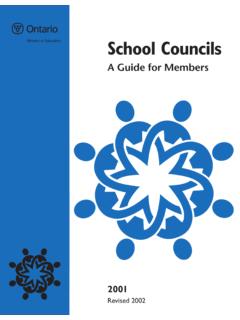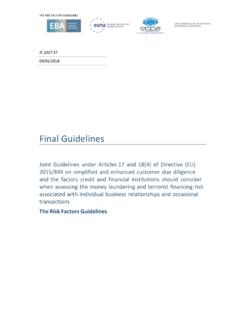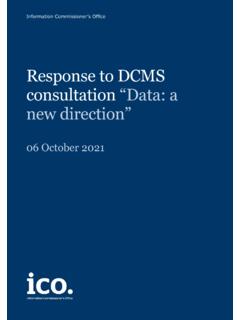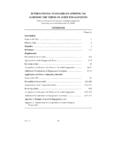Transcription of Evaluation of sensitivity and specificity of four ...
1 Evaluation of sensitivity and specificity of four commercially available SARS-CoV-2 antibody immunoassays Public Health England, Porton Down Nuffield Department of Medicine, University of Oxford Oxford University Hospitals NHS Foundation Trust July 2020 OFFICIAL: Evaluation of sensitivity and specificity of four commercially available SARS-CoV-2 antibody immunoassays 1 About Public Health England Public Health England exists to protect and improve the nation s health and wellbeing, and reduce health inequalities. We do this through world-leading science, research, knowledge and intelligence, advocacy, partnerships and the delivery of specialist public health services. We are an executive agency of the Department of Health and Social Care, and a distinct delivery organisation with operational autonomy. We provide government, local government, the NHS, Parliament, industry and the public with evidence-based professional, scientific and delivery expertise and support.
2 Public Health England Wellington House 133-155 Waterloo Road London SE1 8UG Tel: 020 7654 8000 Twitter: @PHE_uk Facebook: Crown copyright 2020 You may re-use this information (excluding logos) free of charge in any format or medium, under the terms of the Open Government Licence To view this licence, visit OGL. Where we have identified any third party copyright information you will need to obtain permission from the copyright holders concerned. Published July 2020 PHE publications PHE supports the UN gateway number: GW-1386 Sustainable Development Goals Evaluation of sensitivity and specificity of four commercially available SARS-CoV-2 antibody immunoassays 2 Contents Executive summary 3 1. Introduction 5 2. Methods 7 3. Results: Primary analysis 11 4. Results: Secondary analysis 13 5. Conclusions 17 6. Appendix 18 7. References 30 8. Supporting corporate information 31 Evaluation of sensitivity and specificity of four commercially available SARS-CoV-2 antibody immunoassays 3 Executive summary Public Health England (Porton Down) and a clinical/research team at the University of Oxford and Oxford University Hospitals NHS Foundation Trust were commissioned by the Department of Health and Social Care (DHSC) to evaluate several commercial immunoassays for SARS-CoV-2 antibody detection available on the UK market.
3 An external appraisal of assay performance is highly desirable in order to determine performance metrics with precision, using a large, well-characterised sample set. Over a three-week period in May-June 2020, we evaluated four SARS-CoV-2 antibody assays, namely Abbott s SARS-CoV-2 Immunoassay, DiaSorin s LIAISON SARS-CoV-2 S1/S2 IgG, Roche s Elecsys Anti-SARS-CoV-2, and Siemens SARS-CoV-2 Total (COV2T) (referred to as Abbott, DiaSorin, Roche, and Siemens assays hereafter). Assays were performed in line with the manufacturers instructions and at the pre-specified thresholds for determining positive vs negative test results. For each test, we calculated sensitivity and specificity , to compare against the UK Medicines and Healthcare products Regulatory Agency (MHRA) Target Product Profile (TPP) for enzyme immunoassays for SARS-CoV-2. sensitivity was evaluated on 536 positive samples from unique adult individuals with laboratory-confirmed SARS-CoV-2 infection at 20 days post-symptom onset; specificity was evaluated on 994 pre-pandemic (2015-2018) specimens from unique, healthy adult individuals.
4 Primary results were as follows: Assay sensitivity [95% CI] specificity [95% CI] Appraisal against MHRA Target Product Profile (TPP) Abbott ( , ) ( , 100) Meets specificity criterion DiaSorin ( , ) ( , ) Meets specificity criterion Roche ( , ) ( , 100) Meets specificity criterion Siemens ( , ) ( , 100) Meets sensitivity and specificity criteria Evaluation of sensitivity and specificity of four commercially available SARS-CoV-2 antibody immunoassays 4 We also undertook secondary analyses, highlighting that the Roche assay could meet the current MHRA TPP sensitivity criteria with an assay threshold adjustment (eg at a revised assay threshold of the sensitivity would be [95% CI: , ] with a specificity of [95% CI: , ]). Further, by optimising assay thresholds to achieve a specificity of 98% and extending the sample timeframe specification to 30 days post-symptom onset (in lieu of the current MHRA TPP specification of 20 days), all four assays would meet the sensitivity criteria.
5 Evaluation of sensitivity and specificity of four commercially available SARS-CoV-2 antibody immunoassays 5 1. Introduction SARS-CoV-2 has emerged as a novel cause of human infection, causing a global pandemic in the first 6 months of 2020, with > million confirmed cases of infection and 443K deaths (1). Case ascertainment and testing have been critical to controlling the spread of infection, and in developing effective strategies to mitigate the public health and economic impact of this pathogen. Laboratory testing for SARS-CoV-2 broadly takes two forms: firstly, direct detection of the presence of virus, by testing respiratory samples with real-time PCR (RT-PCR), and secondly, an assessment of the immunological response to infection, by using serology to determine the presence of antibody (2), and/or neutralisation assays to evaluate the capacity of antibodies to effectively target the virus. Neutralisation assays are time- and resource-intensive tests, and are currently limited in their capacity for rollout.
6 Serological diagnosis has therefore been pursued, with the aim of detecting either specific types of SARS-CoV-2 antibody (IgM, IgG, IgA), or total antibody, supporting several aims: at a population level, determining exposure provides insight into spread in communities and healthcare settings, identification of risk groups, and supports tracking and modelling of infection over time at an individual level, antibodies are deemed likely to be a correlate of protection against future infection, and may therefore contribute to managing personal risk-assessments to support research and development, antibody measurement is a critical tool, particularly in providing quantification of antibody responses in vaccine trials Antibodies to SARS-CoV-2 typically start to appear >5-7 days after infection (3, 4), and are therefore an unreliable marker for early acute infection. Importantly, it remains unclear what degree of immunity the presence of antibody confers, and how durable this might be.
7 To cope with the demand for serological diagnosis, several manufacturers have developed immunoassays that are compatible with current global laboratory infrastructures, including high-throughput analyzers. However, assembling appropriate and large sets of samples to thoroughly test the performance of these assays has been difficult within the very short time frames of assay development and release, and direct comparisons of platforms have been limited. Evaluation of sensitivity and specificity of four commercially available SARS-CoV-2 antibody immunoassays 6 The UK Medicines and Healthcare products Regulatory Agency (MHRA) has recently released a Target Product Profile for enzyme immunoassays (5) to support Pillar 3 of the UK testing strategy ( Mass-antibody testing to help determine if people have immunity to coronavirus (6)), specifying: a clinical sensitivity of 98% (95% CI: 96-100%) in confirmed SARS-CoV-2 positive cases (defined by RT-PCR) 20 days after the appearance of first symptoms; a clinical specificity of 98% (95% CI: 96-100%) on samples collected >6 months before the first identified cases of SARS-CoV-2 infection The sensitivity of a test characterises its capacity to identify known positives (ie infected individuals), and the specificity its capacity to identify known negatives (ie uninfected individuals).
8 Of note, there is no clear gold standard against which to evaluate these antibody tests; PCR-positivity is a proxy for the expected presence of antibody, but negative antibody tests in PCR-positive individuals could either represent an issue with antibody test performance, or alternatively be explained by a failure to mount a measurable antibody response (eg in immunocompromise), or through a false-positive PCR test in individuals who have not genuinely had SARS-CoV-2 infection. To directly evaluate and compare the sensitivity and specificity of four commercial immunoassays for SARS-CoV-2 antibody (Abbott, DiaSorin, Roche, Siemens; Table S1), we formed a collaboration between Public Health England -Porton Down, Oxford University Hospitals NHS Foundation Trust, and the University of Oxford. Using a large collection of serum/plasma samples from individuals with SARS-CoV-2 infection confirmed by RT-PCR, and a bank of known negative samples collected pre-pandemic, we ran the same samples across all four platforms in a head-to-head Evaluation .
9 Evaluation of sensitivity and specificity of four commercially available SARS-CoV-2 antibody immunoassays 7 2. Methods We developed a written protocol for the head-to-head Evaluation , which was shared with the four commercial companies and with DHSC at the outset. We provided manufacturers with the opportunity to raise questions and feedback on the protocol. The full data and analysis, including the protocol, will be submitted for publication on a pre-print server (publicly accessible) and in a peer-reviewed journal as soon as possible. Samples for testing were collected from adults in the UK, in line with MHRA TPP specifications, namely a known negative group of samples collected >6 months prior to the known appearance of SARS-CoV-2 (ie sample collection earlier than July 2019), and a known positive group of samples collected from individuals with a previous positive SARS-CoV-2 RT-PCR nose/throat swab, with blood samples taken 20 days post-symptom onset.
10 In total, 994 samples from 994 individuals were included in the sensitivity / specificity analyses as the known negative cohort, and 536 samples from 536 individuals as the known positive cohort. Sample selection and exclusions are shown in Figure 1; characteristics of included samples are presented in Table 1. Evaluation of sensitivity and specificity of four commercially available SARS-CoV-2 antibody immunoassays 8 Figure 1. Sample collections and inclusions/exclusions. For de-duplication of samples by individual, the latest sample meeting the MHRA criteria (ie latest sample taken 20 days after symptom onset) was included. Table S2 summarises the partial results for the five samples that were of insufficient volume to run across all platforms. Evaluation of sensitivity and specificity of four commercially available SARS-CoV-2 antibody immunoassays 9 Table 1. Summary of serum samples used for head-to-head analysis of four commercial immunoassay platforms for the detection of SARS-CoV-2 antibodies Group Source Number of samples Days from symptom onset, median (IQR; min, max; number of samples) Days from PCR-positive test, median (IQR; min, max; number of samples) Known negative Healthy individuals 30-50 years of age, collected between 2015-2018 in Oxfordshire (Oxford BioBank, ) 994 n/a n/a Known positive Healthcare workers and patients 18 years of age at Oxford University Hospital NHS Foundation Trust, Oxfordshire, UK 158 37 (28-53; 20, 73; n=158) 27 (22-36; 3, 59; n=105) Known positive Volunteer plasma donors 18 years of age via NHS Blood and Transplant (NHSBT), across the UK 378 All samples 28 days post-symptom onset* 44 (40-49; 32, 82.)
















